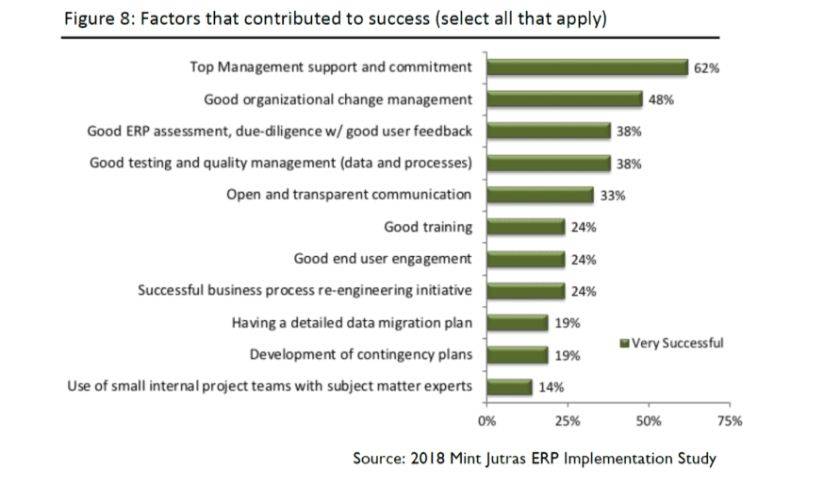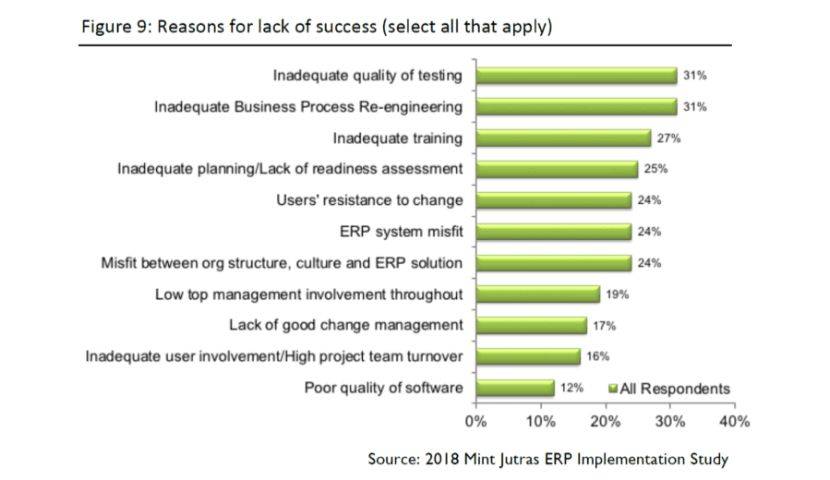A typical question we hear from manufacturing and distribution companies is what a successful enterprise technology project looks like.
The recent ERP Implementation survey Ultra Consultants commissioned from MintJutras answers that question, and also explores other factors when it comes to driving a successful enterprise technology project.
Entitled “The Real Facts about ERP Implementations,” Mint Jutras surveyed hundreds of North American manufacturing and distribution companies.

As an independent ERP consulting firm, ERP implementation success is a topic that comes up often as project teams look to Ultra to understand the best way to work through enterprise system projects.
Our survey of mid-market manufacturing and distribution organizations showed that most of the reasons for success have more to do with the organization (people and processes) than with the software itself.
Good planning and organization clearly pay off.
The chart below displays what those who were most successful felt contributed to their ability to exceed expectations.

Notice that most of these success factors are related to how a project is managed, rather than the technology itself.
What Causes Challenges?
The MintJutras survey uncovered some of the key reasons that IT projects fail to deliver on expectations, noted in the chart below.

These findings support what we’ve seen out in the field when we partner with an ERP project team.
Through the work we do with manufacturing and distribution organizations, some of the common reasons why IT projects spiral out of control include:
- Unclear or unrealistic expectations for what the project is trying to accomplish
- Change management is viewed as expendable, low on the project priority, and people are not brought along in the journey
- Specific technical challenges plague projects – interfaces, and master data. Interfaces are complex and often take longer than expected. And as we mentioned, data cleansing and migration is often oversimplified.
- Inadequate testing – it’s important to test processes end to end.
- No action plans or meaningful metrics are developed to provide guidance or monitor progress
Looking deeper, Ultra Consultants is regularly called into a manufacturing or distribution company for guidance when it comes to “project recovery” – especially when an ERP software project spirals out of control.
So of the reasons listed above, we see the prime reason for project failure is that the enterprise is more focused on the demands of day-to-day operations and is unable to think in terms of business process transformation and operational change as it deploys new enterprise technology.
Managing Change
When it comes to driving a successful enterprise technology project, organizational change management is an absolute requirement when implementing an enterprise solution.
The ability to effectively manage change may very well be the most important skill that executives, managers and employees need to master.
As an independent ERP consulting firm, we’re in a unique position to understand what it takes to drive a successful enterprise technology project. Business transformations through ERP will not take place without effectively managing change across three key organizational areas: people, process, and technology. Change management planning from the very beginning is essential.
The 7 Deadly Sins of ERP Implementation
Some mistakes are just bad strategic or financial decisions. Some are the inevitable consequence of situational or organizational factors. Some, however, are the result of process-oriented or people-centric choices – and are easily avoided. These are The Seven Deadly Sins of ERP Implementation.
Table of Contents
More ERP material...
AI in Food and Beverage Manufacturing
Discover how AI is revolutionizing food and beverage manufacturing, enhancing quality, reducing…
How ERP for Quality Control Eliminates Manual Documentation Chaos
This post will examine why managing quality records outside of an ERP…
Assessing Your AI Maturity
This article breaks down how businesses can measure their AI maturity to…




